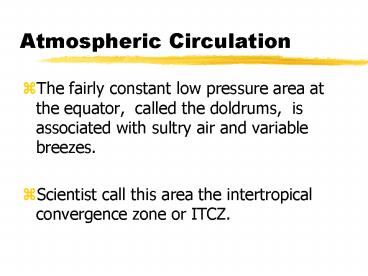Atmospheric Circulation PowerPoint PPT Presentation
1 / 25
Title: Atmospheric Circulation
1
Atmospheric Circulation
- The fairly constant low pressure area at the
equator, called the doldrums, is associated
with sultry air and variable breezes. - Scientist call this area the intertropical
convergence zone or ITCZ.
2
Atmospheric Circulation
- The term intertropical convergence zone is used
to reflect the influence of wind convergence on
conditions near the equator. - Strong heating in the ITZC causes warm moist to
rise, expand and lose moisture as rain. - These are perfect conditions for the success of
tropical rain forests.
3
Atmospheric Circulation
- The ITZC does not coincide with the geographical
equator at 0-degrees of latitude, but it lies at
the meteorological equator or thermal equator
which changes with the seasons.
4
Monsoons
- A monsoon is a pattern of wind circulation that
changes with seasons. The word is derived from
an Arabic word which means seasons. - Monsoons are linked to the different specific
heats of land and water. - In spring the land heats more rapidly than the
ocean.
5
Monsoons
- Air above the land becomes warmer and rises.
Relatively cool air from over the ocean moves in
to replace the rising air over land. - Continental heating causes this humid air to
rise, condense, and form clouds and rain.
6
Monsoons
- In autumn the land cools more rapidly than the
adjacent ocean. Air cools and sinks over the
land, and dry surface winds move seaward. - The intensity and location of monsoon activity
depends on the position of the ITCZ.
7
Mini-Monsoons
- Land breezes and sea breezes are small, daily
mini-monsoons. - Morning sunlight falls on both the land and the
adjacent ocean evenly. - The temperature of the water doesnt rise as much
as the temperature of the land. The inland rocks
transfer heat to the air and causes it to rise.
8
Mini-Monsoons
- This creates a low pressure area over the land
and causes cooler (higher pressure) air from over
the ocean to move in and replace the air rising
over the land. - This is called a sea breeze.
- The situation reverses after sunset and the
result is a land breeze.
9
Storms
- Storms are regional atmospheric disturbances
characterized by strong winds and frequently
accompanied by precipitation. - The two great storms on Earth are tropical
cyclones and extratropical cyclones.
10
Storms
- Most of us are quite familiar with tropical
cyclones as the Atlantic hurricanes which occur
in summer in the Northern Hemisphere. - Extratropical cyclones are winter disturbances
which residents of the Eastern Seaboard are
familiar with. These mainly occur in the Ferrel
cells of each hemisphere
11
Storms
- Both kinds of cyclones are huge masses of low
pressure air in which winds converge and ascend. - The most powerful storm on Earth is the
hurricane. - Hurricanes occur in all tropical oceans except
the equatorial South Atlantic.
12
Hurricanes
- From above, tropical cyclones appear as circular
spirals. They may be 1,000 kilometers (620
miles) in diameter and 15 kilometers (9.3 miles)
high. - The center of the storm is call the eye and may
be 13 - 16 kilometers (8-10 miles) in diameter.
13
(No Transcript)
14
Hurricanes
- Hurricanes form from warm, humid air masses
between 10 and 20 degrees latitude in both
hemispheres. - They do not form closer to the equator because
the Coriolis effect is too weak to initiate the
rotary motion. - A tropical cyclone usually develops from a small
tropical depression.
15
Hurricanes
- When air containing a tropical disturbance is
heated over tropical water with a temperature of
about 26-degrees C (79-degrees F), or greater
circular winds begin to blow in the vicinity of
the wave, and some of the warm, humid air is
forced upward. - Condensation takes place and the storm takes
shape.
16
(No Transcript)
17
Hurricanes
- If conditions are ideal the storm will reach
hurricane status, with wind speeds in excess of
119 kilometers (74 miles) per hour in two to
three days. - The centers of most tropical cyclones move
westward and poleward at 5-40 kilometers ( 3-25
miles) per hour.
18
(No Transcript)
19
Hurricanes
- Tropical cyclones are an ideal machine for
cashing in on water vapors latent heat of
evaporation. - Three aspects of a tropical cyclone can cause
property damage and loss of life. - They are wind, rain and the storm surge.
- The most dangerous of these is the storm surge.
20
Hurricanes
- The storm surge is a wall of seawater forced on
shore by the low pressure of the hurricane. - The water height increases when waves and strong
hurricane winds ram the water mass ashore.
21
Hurricanes
- You may have noticed that tropical cyclones turn
counterclockwise in the Northern Hemisphere. - This does not mean that the Coriolis effect does
not apply to them. - This apparent anomaly is caused by the Coriolis
deflection of winds approaching the center of a
low pressure area from a great distance.
22
In the diagram below note the rightward
deflection of the approaching air. The edge spin
given by this approach causes the storm to spin
counterclockwise.
23
Tropical Storm speed
- A tropical disturbance is a rotary circulation
with little to no development on the ocean
surface, but better developed in the upper
atmosphere. - A tropical depression is a rotary circulation on
the ocean surface and sustained wind speed of
less than 39 miles per hour. - A tropical storm is a low-pressure area with a
distinct rotary circulation and sustained wind
speeds of 39 to73 mph.
24
Categories of Storms
25
Hurricanes
- Tropical cyclones are natures escape valves,
flinging solar energy poleward from the tropics.

